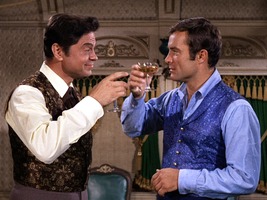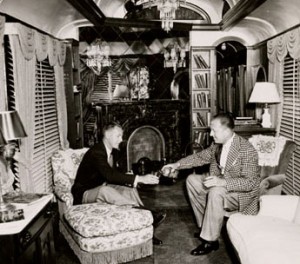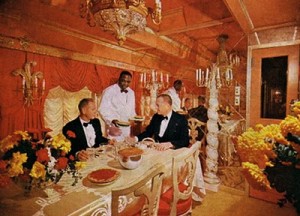
Over the past few evenings, Meg and I have been enjoying binge-watching our way through a DVD reissue set of the 1960s TV Series, “The Wild, Wild West”. We both really liked it as kids, we’re both fans of cheapo western action serials of the 30’s and 40’s, and this series borrows very heavily from that cannon (literally–it was shot at CBS Radford, AKA the old Republic Studios lot–home of a very distinctive old western street set, along with props and sets previously used by John Wayne, Roy Rogers, Dale Evans, The Three Mesquiteers, Andy Devine, etc.). Compared to Republic serials, the CBS western shows were high budget–not a lot of reused footage, better writing, much better bad guys, and a much greater supply of breakaway bottles, chairs, windows, and pianos were consumed in the course of the fight scenes.
Private RR car fans frequently single out this TV show as the main reason why they first became interested in the dream of owning their own private railroad car. Like any Homeric hero story, a lot of attention gets paid to the hero’s means of transportation. Heroes always need unusual rides–Jason had the Argo, Christ had a donkey, Batman had the Batmobile, Roy had Trigger, and Kirk had the Enterprise. In “The Wild Wild West”, James West and his assistant Artemus Gordon cruise the Old West in “the Wanderer” an 1870s era wooden private car that typically traveled in a train with another car (a stable and workshop car). Never seen, but implied in the story, they traveled with a locomotive engineer, brakeman and a conductor–they must have slept in the coal bunker and survived on cans of sardines. The Wild, Wild West makes it look like a very suave and sophisticated way for a secret agent cowpoke to get around the prairie. West and Gordon had lots of cool stuff on the car: hidden maps, telegraphy equipment, a chemistry lab, carrier pigeons, guns, explosives. Never had any trouble talking their dates into coming back to the car for some brandy, a private car will have that affect on a lass.
The exterior shots of the train show an engine and two cars that were originally owned by the Virginia and Truckee Railroad. In the 1930s, they were part a large set of railroad equipment acquired by Paramount Pictures which appeared in many movies in the 40s and 50s. In the 1960s, Paramount sold the entire collection off, but happily, much of it wound up being saved and has found their way into museums. West’s loco and cars are currently at the Nevada State Railroad Museum in Carson City.
Though the exteriors were nicely painted for the show, the cars were very plain on the inside, and their interiors were never used in the series. The opulent Victorian Baroque car private car interiors seen in the show existed only as studio sets, but most historical rail equipment fans will remark about the strong resemblance between the sets, and well-circulated, published photos of the interiors of “The Gold Coast”, and the “Virginia City”–the two railroad cars owned by newspaper columnist Lucius Beebe and his partner Charles Clegg.

Beebe and Clegg’s first railroad car, the “Gold Coast” operated into the 1950s. At that point railroads had started to object to handling older wooden cars made prior to 1910, and put pressure on the pair to come up with a newer car. As a result, they built the Virginia City–a heavyweight-era open-platform Pullman car that had served lounge car on the Overland limited. Their friend, Hollywood production designer Robert Hanley, came up with the Baroque design for the interior, and along the way, found a method to make a fireplace work on a railroad car. Today, the “Gold Coast” can be found at the California Railroad Museum in Sacramento, while the Virginia City continues to carry passengers, and occupy the rearmost position on Amtrak Trains, privately owned and operated by Wade Pellizer. More information can be found at the Virginia City site: http://www.vcrail.com/vchistory_railcars.htm

This article has brought back some memories from my childhood, watching the Wild, Wild, West show. I remember the show as one of the ones that I used to watch, like Star Trek, Space:1999, Hogan’s Hero’s, F Troop when I was young. I remember shows like Happy Days, Three’s Company, Mork and Mindy, All in the Family, Welcome Back Kotter watching them weekly without missing them. They don’t make like they used anymore. But it’s been pleasant memories just thinking about them.
Comment by John D. — November 3, 2013 @ 10:38 am
You’re right–they really don’t make TV like they used to. Not a lot of heroic leads any more– nowadays good guys are kind of checkered and the bad guys are nuanced. And they don’t rumble with the bad guy’s lackeys twice an hour.
Comment by Tom — November 3, 2013 @ 10:05 pm
I am keenly interested in seeing the brass railing of the rear of the train in good detail. Does the car at the Nevada State Railroad Museum still have that railing or was it removed. Who has a good picture of it.
Comment by Debbie Milka — February 9, 2018 @ 1:31 pm
HI Debbie– I’ve never been to the Nevada State Railroad Museum, and don’t know the specifics of the cars they acquired. It wouldn’t surprise me if none of their coaches had the fancy ornate platform details. For the TV show, production designer Albert Heschong devised a small set-piece featuring the Wanderer’s rear platform along with a few feet of the lounge (both interior and exterior were decorated) which was mounted on the back of a truck. With the camera properly set up, they could do a scene containing actors waving from the rear as the train pulled away from a train station on the backlot at CBS Radford, which didn’t have any rail sidings.
There’s a few pretty obvious clues: the set is wider than 12 feet (standard width for a railroad car), and it’s too low to the ground for standard platform height. Much of it looks like painted wood dressed to look like metal, and it is way too lightly built to be a real RR car. As a set, it’s perfect though. Big enough for a few actors doing a fight scene, closer to the ground so it’s easier to climb onto with panache, and there are nooks to stash lights and microphones. Furthermore– you can drive the rig into a soundstage, get perfect audio and lighting, and can shoot evening scenes in the daytime.
Heschong was no doubt inspired by Beebe and Clegg’s two railroad cars (The Gold Coast, which is now at the California State Railroad Museum in Sacramento), as well as their second car the privately-owned, San Francisco-based Virginia City (they needed to upgrade to an all-steel car in the 1950s as railroads were retiring wooden cars, so they had a second one built). These two cars are the real deal. While it might have been possible for the producers of the Wild Wild West to arrange to use one of these cars, in practice he truck-mounted set was was cheaper and more convenient, and the westerns produced on the Radford lot in the 1960s (list includes the shows Rawhide, Gunsmoke, Wild Wild West, and Big Valley) relied more on character and action, than realism to entertain. There was a lot of crossing over of sets, costumes and props for these four shows.
Comment by Tom — February 9, 2018 @ 4:14 pm